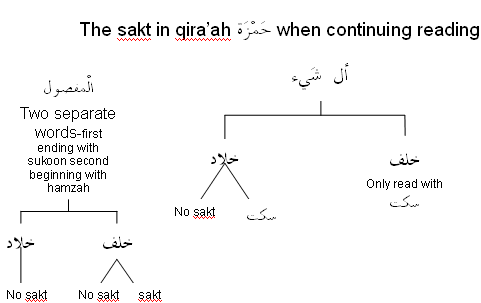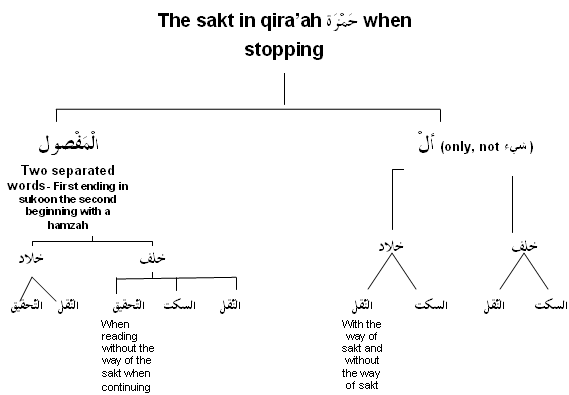Question
Assalaamu ‘alaykum
I
really benefit tremendously from your site. Got bless you all.
Can you please explain exactly when Khalaf and Khallad make
sakta according to the tariq shatebeyya and when they make
naql. Could you also include imam Shatebi’s poem on this poem or proof
for reciting in this way.
Shukran. Wassalaam
Answer
Wa
alaikum assalaam wa rahmatullahi wa barakatuh.
The question requires a great deal of explanation and is actually
encompasses two lessons in the reading of
 .
.
 has
a
has
a  without another
allowed way on words starting with
without another
allowed way on words starting with
 followed
by a hamzah, such as the words:
followed
by a hamzah, such as the words:
 ,
,
 , and
, and
 , and the word
, and the word
 with any of the
three vowels on the end. This is when we are not stopping on any of these
words.
with any of the
three vowels on the end. This is when we are not stopping on any of these
words.
 has
a
has
a  as one of two
possible allowed ways of reading the same above categories of words, the
other way being with no
as one of two
possible allowed ways of reading the same above categories of words, the
other way being with no
 , when not stopping.
, when not stopping.
In
addition to this,
 has
has  on words ending
with a sukoon followed by a word beginning with a hamzah, as one of two
possible ways of reading these words, the other allowed way is without a
on words ending
with a sukoon followed by a word beginning with a hamzah, as one of two
possible ways of reading these words, the other allowed way is without a
 . Examples are:
. Examples are:  ,
,

Again the rule changes when stopping on a word. Khallad does not have a
 on a saakin before a
word starting with a hamzah (between two words).
on a saakin before a
word starting with a hamzah (between two words).
The Shaatibiyyah describes this rule, but not in great detail in the
following lines:

And from
Hamzah when stopping there with one of two allowed ways [referring to
 ]
and he has
]
and he has
It is narrated that
Khalaf when continuing has a light sakt.
And he makes sakt on
“shay’in” and “shay’an” and some of them
In the “laam” of the
definite article from Hamzah recited.
And shay’in and shay’an
and he didn’t add to it.
Another scholar
wrote the following lines that describe how and when Khalaf and Khallaad
read with a
 :
:

And shay’in
and al ( )
with a sakt Khalaf without
)
with a sakt Khalaf without
A different [way]
and in the separated [words] Khalaf accepts [as one of two allowable ways]
And Khallad with
khulf in al and its shay
And nothing in the
separated [words] from him occurs.

The reading of
 has
special rules when stopping on a word that has a hamzah in the middle
(anywhere but the first letter) or the end. We will not describe this vast
chapter here; anyone wishing to learn about this can refer to the
Shatibiyyah poem and a book that explains the Shatibiyyah poem. We will
describe how
has
special rules when stopping on a word that has a hamzah in the middle
(anywhere but the first letter) or the end. We will not describe this vast
chapter here; anyone wishing to learn about this can refer to the
Shatibiyyah poem and a book that explains the Shatibiyyah poem. We will
describe how
 and
and
 stop
on these words that are read with
stop
on these words that are read with
 , or are allowed to be
read with a
, or are allowed to be
read with a  as one of
two allowable ways of reading.
as one of
two allowable ways of reading.
If there is a word beginning with
 and
followed by a hamzah (as in
and
followed by a hamzah (as in  )
and we are stopping on this word,
)
and we are stopping on this word,
 reads
the word with two allowable ways, one way is with
reads
the word with two allowable ways, one way is with
 of
the vowel on the hamzah to the
of
the vowel on the hamzah to the
 saakinah of the
saakinah of the
 ,
just as in the reading of Warsh (
,
just as in the reading of Warsh ( ).
The other allowable way of reading one of these words when stopping is with
a
).
The other allowable way of reading one of these words when stopping is with
a  , just as it is read
when continuing.
, just as it is read
when continuing.
If
we are reading
 with
the allowed but not compulsory
with
the allowed but not compulsory
 , then the same kind
of words are read with the two allowable ways described above just as
, then the same kind
of words are read with the two allowable ways described above just as
 does.
If however, we are reading the other allowable way (without a
does.
If however, we are reading the other allowable way (without a
 ) on these words (when
continuing reading), then when stopping on these words, they are only read
with naql.
) on these words (when
continuing reading), then when stopping on these words, they are only read
with naql.
The word  , is not
stopped on with a
, is not
stopped on with a  in
the reading of
in
the reading of
 and
follows the rules in the chapter of Hamzah and Hishaam stopping on a
hamzah.
and
follows the rules in the chapter of Hamzah and Hishaam stopping on a
hamzah.
When on reading
 stops
on the two word combinations that have a sukoon on the end of a word and a
hamzah as the first letter of the next word (as in
stops
on the two word combinations that have a sukoon on the end of a word and a
hamzah as the first letter of the next word (as in
 ) he stops
with
) he stops
with  ,
,
 or
or
 as two allowable ways
when he is reading these words when continuing with a
as two allowable ways
when he is reading these words when continuing with a
 . When reading
. When reading
 and
if not reading these word combinations with
and
if not reading these word combinations with
 when continuing,
these words are stopped on with a
when continuing,
these words are stopped on with a
 (transfer)
of the vowel on the hamzah to the sukoon on the last letter on the word
before it or
(transfer)
of the vowel on the hamzah to the sukoon on the last letter on the word
before it or  ,
which means the words are read as they are written and the hamzah is not
changed. When reading with the way allowing a
,
which means the words are read as they are written and the hamzah is not
changed. When reading with the way allowing a
 between two words and
stopping on a two word combination with a sukoon on the end of the first
word and a hamzah as the first letter of the next word, there is two allowed
ways of stopping, that of
between two words and
stopping on a two word combination with a sukoon on the end of the first
word and a hamzah as the first letter of the next word, there is two allowed
ways of stopping, that of
 and
and
 .
.
In
the reading of
 ,
when stopping on a two word combination that has a sukoon on the end of the
first word and a hamzah as the first letter of the next word (as in:
,
when stopping on a two word combination that has a sukoon on the end of the
first word and a hamzah as the first letter of the next word (as in:
 ) there are
two allowed ways of stopping: One being that of the
) there are
two allowed ways of stopping: One being that of the
 (transferring
the vowel of the hamzah to the saakin before it) and that of
(transferring
the vowel of the hamzah to the saakin before it) and that of
 meaning each
letter is pronounced as written and there is no change in the hamzah.
meaning each
letter is pronounced as written and there is no change in the hamzah.

The lines of the Shatibiyyah for
 when
stopping are:
when
stopping are:

You are welcome. Wa assalaam alaikum wa rahmatullah.